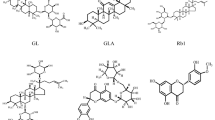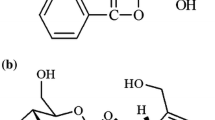Abstract
The US patented polyherbal formulation for the prevention and management of type II diabetes and its vascular complications was used for the present study. The xanthone glycoside mangiferin is one of the major effector constituents in the Salacia species with potential anti-diabetic activity. The pharmacokinetic differences of mangiferin following oral administration of pure mangiferin and polyherbal formulation containing Salacia species were studied with approximately the same dose 30 mg/kg mangiferin and its distribution among the major tissue in Wistar rats. Plasma samples were collected at different time points (15, 30, 60, 120, 180, 240, 360, 480, 600, 1,440, 2,160, and 2880 min) and subsequently analyzed using a validated simple and rapid LC-MS method. Plasma concentration versus time profiles were explored by non-compartmental analysis. Mangiferin plasma exposure was significantly increased when administered from formulation compared to the standard mangiferin. Mangiferin resided significantly longer in the body (last mean residence time (MRTlast)) when given in the form of the formulation (3.65 h). Cmax values of formulation (44.16 μg/mL) administration were elevated when compared to equivalent dose of the pure mangiferin (15.23 μg/mL). Tissue distribution study of mangiferin from polyherbal formulation was also studied. In conclusion, the exposure of mangiferin is enhanced after formulation and administration and could result in superior efficacy of polyherbal formulation when compared to an equivalent dose of mangiferin. The results indicate that the reason which delays the elimination of mangiferin and enhances its bioavailability might the interactions of the some other constituents present in the polyherbal formulation. Distribution study results indicate that mangiferin was extensively bound to the various tissues like the small intestine, heart, kidney, spleen, and liver except brain tissue.




Similar content being viewed by others
REFERENCES
Dubey GP, Agrawal A, Dubey N, Dubey S, Dubey R, Deborah S, inventors; University S, assignee. Herbal formulation for the prevention and management of type-2 diabetes mellitus and vascular complications associated with diabetes. US patent 8337911B2. 25 Dec 2013.
Yuhao L, Tom HWH, Johji Y. Salacia root, a unique Ayurvedic medicine, meets multiple targets in diabetes and obesity. Life Sci. 2008;82:1045–9.
Yoshikawa M, Nishida N, Shimoda H, Takada M, Kawahara Y, Matsuda H. Polyphenol constituents from Salacia species: quantitative analysis of mangiferin with alpha-glucosidase and aldose reductase inhibitory activities. Yakugaku Zasshi. 2001;121:371–8.
Ichiki H, Miura T, Kubo M, Ishihara E, Komatsu Y, Tanigawa K. New antidiabetic compounds, mangiferin and its glucoside. Biol Pharm Bull. 1998;21(12):1389–90.
Garcia D, Leiro J, Delgado R, Sanmartin M, Ubeira F. Mangifera indica L. extract (Vimang) and mangiferin modulate mouse humoral immune response. Phytother Res. 2003;17:1182–7.
Muraoka O, Xie W, Tanabe G, Amer M, Minematsu T, Yoshikawa M. On the structure of the bioactive constituent from ayurvedic medicine Salacia reticulata: revision of the literature. Tetrahedron Lett. 2008;49:7315–7.
Sanchez GRL, Giuliani A, Nunez SA, Davison G, León-Fernández FO. Protective effects of Mangiferin indica L extract mangiferin and selected antioxidants against TPA-induced biomolecules oxidation and peritoneal macrophage activation in mice. Pharmacol Res. 2000;42(6):565–73.
Liu Y, Xu F, Zeng X, Yang L, Deng Y, Wu Z, et al. Application of a liquid chromatography/tandem mass spectrometry method to pharmacokinetics study of mangiferin in rats. J Chromatogr B. 2010;878(32):3345–50.
Dai R, Gao J, Bi K. High-performance liquid chromatographic method for the determination and pharmacokinetic study of mangiferin in plasma of rats of rats having taken the traditional Chinese medicinal preparation Zi-Shen pill. J Chromatogr Sci. 2004;42:88–90.
Wu H, Zhu Z, Zhang G, Zhao L, Zhang H, Zhu D, et al. Comparative pharmacokinetic study of paeoniflorin after oral administration of pure paeoniflorin, extract of Cortex Moutan and Shuang-Dan prescription to rats. J Ethnopharmacol. 2009;125:444–9.
Zuo F, Zhou ZM, Zhang Q, Mao D, Xiong YL, Wang YL, et al. Pharmacokinetic study on the multi-constituents of Huangqin-Tang decoction in rats. Biol Pharm Bull. 2003;26:911–9.
Di B, Feng N, Liu W. Pharmacokinetic comparison of Shuang-Huang-Lian with different combinations of its constitutional herbs. J Ethnopharmacol. 2006;107:401–5.
Wang CH, Cheng XM, Bligh SW, White KN, Branford-White CJ, Wang ZT. Pharmacokinetics and bioavailability of gentiopicroside from decoctions of Gentianae and Longdan Xiegan Tang after oral administration in rats–comparison with gentiopicroside alone. J Pharm Biomed Anal. 2007;44:1113–7.
Kammalla AK, Ramasamy MK, Aruna A, Dubey GP, Kaliappan I. Development and validation of a RP-HPLC method for the simultaneous determination of Mangiferin. Ellagic acid and Hydroxycitric acid in polyherbal formulation. Pharmacogn J. 2014;6(3):1–6.
Muruganandan S, Srinivasan K, Gupta S, Gupta P, Lal J. Effect of mangiferin on hyperglycemia and atherogenicity in streptozocin diabetic rats. J Ethnopharmacol. 2005;97:497–501.
Guha S, Ghosal S, Chattopadhyay U. Antitumour, immunomodulatory and anti HIV effect of mangiferin, a naturally occurring glucosylxanthone. Chemotherapy. 1996;42:443–51.
Shargel L, Wu-Pong S, Yu ABC. Applied biopharmaceutics and pharmacokinetics. New York: The McGraw-Hill Companies, Inc; 2004.
Hedaya MA. Basic pharmacokinetics. New York: Taylor and Francis Group; 2010.
Mukherjee PK, Wahile A. Integrated approaches towards drug development from Ayurveda and other Indian system of medicines. J Ethnopharmacol. 2006;103:25–35.
Ilango K, Ananth KK, Mohan RK, Aruna A, Dubey G. Emerging need of pharmacokinetics in Ayurvedic system of medicine. Int J Res Ayurveda Pharm. 2013; 4(5): 647.
Yoshikawa M, Nishida N, Shimoda H, Takada M, Kawahara Y, Matsuda H. Polyphenol constituents from Salacia species: quantitative analysis of mangiferin with alpha-glucosidase and aldose reductase inhibitory activities. Yakugaku Zasshi. 2001;121:371–8.
Ranjan KN, Nilmoni S, Rintu B. Probing the interaction of ellagic acid with human serum albumin: a fluorescence spectroscopic study. J Photoch Photobio A. 2007;192:152–8.
Hou S, Wang F, Li Y, L Y, Wang M, Sun D, et al. Pharmacokinetic study of mangiferin in human plasma after oral administration. Food Chem. 2012;132:289–94.
Haug KG, Weber B, Hochhaus G, Butterweck V. Pharmacokinetic evaluation of visnagin and Ammi visnaga aqueous extract after oral administration in rats. Planta Med. 2012;78:1831–6.
He CY, Wang S, Feng Y, Liang S, Lin X, Xu DS, et al. Pharmacokinetics, tissue distribution and metabolism of senkyunolide I, a major bioactive component in Ligusticum chuanxiong Hort. (Umbelliferae). J Ethnopharmacol. 2012;142:706–13.
He F, Luo JB. Pharmacokinetic study of minister adjuvant and guide herbs in Mahuang decoction to ephedrine in monarch herb in vivo. Chinese Tradit Herb Drugs. 2005;36:1313–6.
Acknowledgments
The authors would like to thank the Department of Science and Technology, Government of India, for providing the financial assistance to carry the work and Department of Pharmacology, SRM College of Pharmacy, SRM University, for providing facilities.
Conflict of Interest
The authors declare no conflict of interest.
Author information
Authors and Affiliations
Corresponding author
Electronic supplementary material
Below is the link to the electronic supplementary material.
Rights and permissions
About this article
Cite this article
Kammalla, A.K., Ramasamy, M.K., Inampudi, J. et al. Comparative Pharmacokinetic Study of Mangiferin After Oral Administration of Pure Mangiferin and US Patented Polyherbal Formulation to Rats. AAPS PharmSciTech 16, 250–258 (2015). https://doi.org/10.1208/s12249-014-0206-8
Received:
Accepted:
Published:
Issue Date:
DOI: https://doi.org/10.1208/s12249-014-0206-8




